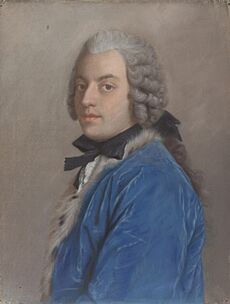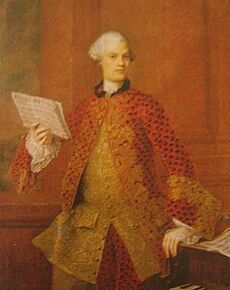Orfeo ed Euridice facts for kids
Quick facts for kids Orfeo ed Euridice |
|
|---|---|
| by Christoph Willibald Gluck | |

Illustration from the first printed score (1764)
|
|
| Librettist | Ranieri de' Calzabigi |
| Language | Italian |
| Based on | myth of Orpheus |
| Premiere | 5 October 1762.: Burgtheater, Vienna |
Orfeo ed Euridice (which means Orpheus and Eurydice in English) is a famous opera by Christoph Willibald Gluck. An opera is like a play where the story is told mostly through singing, with music played by an orchestra. This opera is based on the ancient Greek myth of Orpheus, a talented musician.
The story for the opera was written by Ranieri de' Calzabigi. Orfeo ed Euridice was first performed in Vienna, Austria, on October 5, 1762. It's known as one of Gluck's "reform" operas. This means he wanted to make operas simpler and more focused on the story and feelings, rather than just showing off fancy singing.
This opera is Gluck's most popular work. It has influenced many later operas, including famous ones like Mozart's The Magic Flute and Beethoven's Fidelio. Even though it started with an Italian story, Gluck later changed it for a French audience in Paris in 1774.
Contents
Behind the Scenes: How the Opera Changed
Gluck wanted to make operas more meaningful. He was influenced by ideas from people like Francesco Algarotti. Algarotti believed that in an opera, the story and feelings should be the most important part, not just the music or dancing. He thought operas should "delight the eyes and ears" and "affect the hearts" of the audience.
Gluck's writer, Calzabigi, also believed in these changes. He said that he gave Gluck the "material" for this new kind of dramatic music. Another important influence was Jean-Georges Noverre, a ballet master. He thought dancing in operas should help tell the story, not just be fancy moves. This is why Orfeo ed Euridice has a lot of ballet.
Who's Who: Main Characters
This opera has a small cast of main characters, but they are very important to the story.
| Role | Voice type | Original Singer (1762) | French Version Singer (1774) |
|---|---|---|---|
| Orfeo | alto (high male voice) or haute-contre (high tenor) | Gaetano Guadagni | Joseph Legros |
| Amore (Cupid) | soprano (high female voice) | Lucia Clavereau | Sophie Arnould |
| Euridice | soprano | Marianna Bianchi | Rosalie Levasseur |
| There are also groups of singers and dancers, like shepherds, nymphs, demons, and spirits. | |||
The Story of Orpheus and Eurydice
The opera tells the sad and hopeful story of Orfeo, a musician who tries to bring his beloved wife, Euridice, back from the dead.
Act 1: Orfeo's Sadness and a Ray of Hope
The opera begins with Orfeo and a group of shepherds and nymphs mourning at Euridice's tomb. Orfeo is so sad he can barely speak her name. He sings about his deep sorrow in a famous song called "Chiamo il mio ben" ("I call my beloved").
Suddenly, Amore (Cupid), the god of love, appears. Amore tells Orfeo that he can go to the Underworld and bring Euridice back to life! But there's one strict rule: Orfeo must not look at Euridice until they are both safely back on Earth. Amore encourages Orfeo, telling him his suffering will soon end. Orfeo bravely decides to go on this dangerous journey.
Act 2: Facing the Underworld
Scene 1: The Furies' Challenge
Orfeo arrives at the entrance to the Underworld, a scary, rocky place. Fierce creatures called the Furies guard the entrance. They refuse to let him pass and sing about Cerberus, the three-headed dog that guards the Underworld.
Orfeo, playing his lyre (represented by a harp in the orchestra), begs for pity. At first, the Furies shout "No!" But Orfeo's beautiful, sad singing slowly softens their hearts. He sings "Deh placatevi con me" ("Have pity on me"), and eventually, the Furies let him enter. This scene often includes a powerful "Dance of the Furies."
Scene 2: The Blessed Spirits
Next, Orfeo enters Elysium, a peaceful and beautiful part of the Underworld where good spirits live. This scene features a lovely "Dance of the Blessed Spirits," with a beautiful solo for the flute.
Orfeo is amazed by the beauty, but he still feels sad because Euridice isn't with him yet. He asks the spirits to bring her to him, and they do.
Act 3: The Journey Home and a Tragic Choice
On their way out of the Underworld, Euridice is happy to be returning to Earth. But Orfeo remembers Amore's rule: he cannot look at her. He holds her hand but doesn't look at her or explain why.
Euridice doesn't understand why Orfeo is acting so strangely. She thinks he no longer loves her and is ignoring her. She sings of her heartbreak in the famous aria "Che fiero momento" ("What a cruel moment"), saying she would rather die again than live without his love.
Orfeo can't bear her sadness and reproaches any longer. He turns and looks at her. Immediately, Euridice dies again. Orfeo is filled with despair and sings the most famous song from the opera, "Che farò senza Euridice?" ("What shall I do without Euridice?"). He decides he will die to join her in the Underworld.
But Amore returns just in time to stop him. Seeing Orfeo's deep and lasting love, Amore brings Euridice back to life once more! Orfeo and Euridice are finally reunited. The opera ends with everyone celebrating the power of love in a joyful chorus and a ballet.
Opera Through Time: Performance History
The first performance of Orfeo ed Euridice was a special event for the Emperor's birthday in Vienna in 1762. The main role of Orfeo was sung by a famous singer named Gaetano Guadagni.
Over the years, the opera has been performed many times around the world. Sometimes, the music was changed to fit different singers or audience tastes. For example, in the 19th and 20th centuries, the role of Orfeo was often sung by a female contralto or mezzo-soprano (lower female voices), instead of a high male voice. Famous singers like Kathleen Ferrier and Marilyn Horne were known for playing Orfeo.
More recently, some performances have gone back to Gluck's original idea, using male singers with high voices called countertenors for Orfeo. Modern productions sometimes update the setting, like one in 2017 that showed Orfeo as a choreographer and Euridice as his dancer.
Different Versions of the Opera
Gluck himself made changes to Orfeo ed Euridice over time.
The Paris Version (1774)
Twelve years after the first show, Gluck changed the opera for a performance in Paris. This version was called Orphée et Eurydice and had a French story. Gluck added more music and changed the role of Orpheus to a high tenor voice, which was popular for heroes in French operas. He also added more ballet scenes, as the French audience loved dancing in their operas.
Berlioz's Version (1859)
Much later, in 1859, a famous French composer named Hector Berlioz created another version. He combined parts of Gluck's Italian and French scores. This version was made for a specific mezzo-soprano singer named Pauline Viardot, who wanted to play Orpheus. Berlioz was an expert on Gluck's music, and his version became very popular, helping the opera stay famous.
Gluck's Opera Reforms
Orfeo ed Euridice was the first opera where Gluck really showed his new ideas for opera. He wanted to move away from the old style, where operas often had confusing plots and singers would add lots of extra, fancy notes just to show off.
Instead, Gluck wanted:
- Simpler Songs: He used simpler song forms, like repeating verses with dramatic spoken parts, instead of long, showy songs that stopped the story.
- No More "Dry" Talking: In old operas, characters often just spoke over a simple keyboard. Gluck made sure the orchestra always played along, making the talking more dramatic.
- Clearer Stories: He removed extra side stories to keep the main plot clear and easy to follow.
- More Orchestra: The orchestra became much more important, helping to tell the story and express feelings. For example, in Orfeo's song "Che puro ciel," the orchestra plays the main tune, not just the singer.
- Important Dancing: Like French operas, Gluck's opera used a lot of expressive dancing and big choruses (groups of singers).
Gluck's changes in Orfeo ed Euridice had a huge impact on opera history. His ideas influenced later great composers like Mozart and Wagner. After Gluck, operas became more focused on drama and storytelling, and less on just showing off a singer's voice.
Musical Instruments in the Opera
Gluck made some interesting choices about the instruments in Orfeo. When he changed the opera from Italian to French, he also updated the instruments. For example, he replaced older instruments like cornetts and chalumeaux with more common ones like oboes and clarinets. This was probably because these newer instruments were more widely used in France at the time.
The harp is used to represent Orfeo's lyre, the instrument he plays to charm the Furies. This use of the harp in the 1774 French version is thought to be one of the first times the harp was used in a French orchestra. Gluck even used a second orchestra playing offstage to create an echo effect, which was very clever for his time!
Images for kids
-
Pauline Viardot as Orphée in Berlioz's version.






